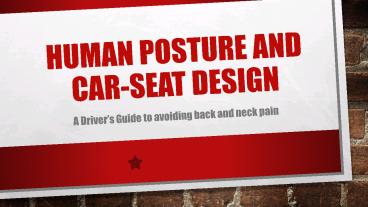Human Posture and Car-Seat Design - PowerPoint PPT Presentation
Title:
Human Posture and Car-Seat Design
Description:
Human Posture and Car-Seat Design A Driver s Guide to avoiding back and neck pain A Driver s ideal posture position Bring Seatback forward at 100 - 110 ... – PowerPoint PPT presentation
Number of Views:83
Avg rating:3.0/5.0
Title: Human Posture and Car-Seat Design
1
Human Posture and Car-Seat Design
- A Drivers Guide to avoiding back and neck pain
2
A Drivers ideal posture position
- Poor posture in the drivers seat can cause many
back and neck issues including - Bulging Discs
- Sciatica
- Herniated Discs
- Arthritis
- To reduce your risk of back or neck injury due to
driving read the tips listed on the right side of
the page.
- Bring Seatback forward at 100? - 110?
- This reduces pressure on the
- discs in the lower back.
- Adjust your headrest to
- the middle of your head.
- This prevents neck fatigue.
- Adjust the seat cushion
- so pressure is distributed
- evenly along the thigh..
- An uneven cushion can cause
- poor circulation and cause
- discomfort.
3
A Companys Unique Vision to create a comfortable
car seat
NASA studies have shown that the human body is
observed to take on a neutral posture when in a
weightless environment. This is the position
that the body wants to take on naturally. Unfortu
nately for most drivers, car seats have
historically been designed in a way that forces
our bodies into an unnatural position. This
actually forces our muscles to work constantly to
maintain our position while we drive. Therefore
it is no surprise that after several hours of
constant work/driving, we can begin to feel
extreme fatigue until now!
Most car seats are not designed to promote good
posture.
4
A new car-seat designed for comfort
- Traditional Car Seats leave gaps of support
- Our new car seat eliminates gaps!
- Support from the Pelvis to the Chest
- This forces other parts of the back to compensate
- More even load distribution saves the spine
- INNOVATION THAT LEAVES YOU FEELING WONDERFUL!
Images provided courtesy of Nissan Corp.
5
What is the ideal seat position?
- (Provided by Cornell University
http//ergo.human.cornell.edu/dea3250notes/sitting
.html) - Seat Height - Optimum seat height is
controversial. - Traditional Criterion - Seat height should be
adjusted to support a knee angle of 90-degrees to
prevent leg swelling. However 75 of leg swelling
may be due to low leg muscle activity rather than
the seat. - Minimum Height - should be 15" (38cm) which
designs to the 5th percentile of women with 1"
heels. The seat should adjust 9" (23cm). - Fixed Height - should be about 17" (43cm). This
is a compromise. A chair that is too high leads
to increased pressure at the popliteal fold
(underside of knees), decreasing blood
circulation and increasing pressure on the nerve.
A seat that is too low increases weight on the
ischial tuberosities. - Seat Pan -
- Seat Depth - recommended is 16.5" for fixed seats
and 14-18.5" for adjustable seats. If the seat
depth is greater than the buttock-popliteal
length (fifth percentile woman is at 17") then
the user won't be able to use the backrest. - Seat Pan Contours - Half body weight is supported
by an 8 area under the "seat bones" (ischial
tuberosities). If the seat is hard and flat the
pressures can be 85-100 p.s.i. Seat contouring
and cushioning can be used to distribute pressure
over a larger area and rotate the pelvis forward
the promote better posture. - Seat Cushioning - recommended thickness at
1.5-2". Cushion should be firmer in back and
thicker while less firm and thinner at front. Too
much cushioning can cause the body to sink into a
chair constraining movement. A soft chair may be
comfortable at first, but as the body sinks blood
circulation lowers, skin temperature rises in
affected areas, and compression under thighs
increases. These factors combine to increase
discomfort. - Cushion Compressibility - Compressibility is
termed indentation load deflection (ILD) or
indentation force deflections (IFD). An ideal
combination is a soft top layer (25 ILD) over a
firm bottom layer (65 ILD). Increased ratios
between the two, greater than 2.6, leads to
better quality support. - Seat Width - around 20 - 22" to accommodate
clothed persons. If seat has armrests then elbow
to elbow breadth may be more relevant. - Seat Angle - Positive seat angle helps user to
maintain good contact with backrest. For most
purposes a 5 - 10 angle is recommended.
6
More on Ideal Seat position
- Armrests - give additional postural support and
aid in standing up and sitting down. Armrests
should be padded and engage the fleshy part of
the forearm. They should not engage the bony
parts of the elbow where sensitive ulnar nerve is
close to the surface so a gap of approximately 4"
between the armrest and seat back is recommended.
Cantilevered elbow rests should be 8-10" above
the seat surface height. Armrests should be at
least 17.2" apart to exceed thigh breadth of 95th
percentile females. Finally, armrests shouldn't
limit chair access if it is to be used at a
table. - Backrests -
- Height - higher backrests give better trunk
weight support. - Medium-level backrest - gives full shoulder
support (e.G. Car seat, office chair) and may
need to be about 26" high to accommodate the 95th
percentile man. - Angle - optimal angle seems to be between
100-110-degrees.































